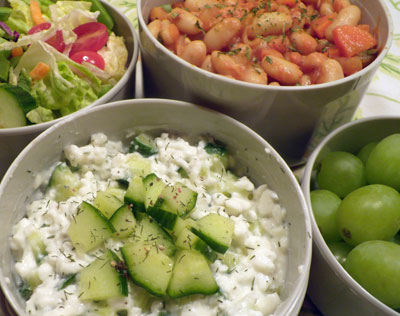Birthdays are inevitable, and with each birthday we get another year older. You gain many things as you age including experience, memories, knowledge, wisdom, and maybe a couple of gray hairs. But while you are increasing your collection of years you are also upping your risk of losing your health. As we get older the metabolism starts to slow down, you quit building bone, and muscle mass starts to decline. It’s a natural process of life, but there is a healthy way to go about it and diet as well as exercise has a huge impact on this.
As the bakery nutrition specialist for Great Harvest, I attended a seminar on Healthy Aging at the recent Food and Nutrition Conference sponsored by the Academy of Nutrition and Dietetics. I was able to gather more pieces to the puzzle of healthy aging. Here are some key points:
Loss of muscle. As we age we lose on average .5-1% of muscle mass every year after the age of 40. Muscle loss means strength and function loss, increased risk of injury, decreased self sufficiency and function as well as a drop in metabolism. Although you can’t prevent aging, you certainly can impact how it affects your body by controlling muscle loss. Currently, about 30% of those over 60 years of age and about 50% of those over 80 years of age have the drastic muscle loss and the corresponding loss in strength and function referred to as sarcopenia.
So what can we do to promote healthy aging?
First, due to a drop in metabolism, your calorie allowance decreases. In fact, for every decade you add to your life your metabolism will slow down about 5%. To maintain your same body weight you need to consume fewer calories than you previously were consuming. In order to meet all of your nutrient needs and control calories simultaneously, what you’re eating should be more nutrient dense. This means eating more fresh fruits and vegetables, replacing refined grains with whole grains, cutting excessive fat and minimizing added sugars.

Secondly, you should focus on protein, which is a major factor in maintaining muscle mass. In fact, you can see a 50% increase in protein synthesis merely with sufficient protein intake. With sufficient protein intake paired with exercise you see approximately a 100% increase in muscle synthesis. The interesting point to note is that studies are showing essentially no differences in protein synthesis levels between the young and the elderly with appropriate protein intake as well as with protein intake paired with exercise.
How much protein is appropriate?
Studies were performed to determine the most effective amount of protein to consume to improve muscle synthesis. What they found was that 30 grams of protein at a given time produced the greatest increase in protein synthesis. They also continued to test protein synthesis rates with protein intake greater than 30 grams at a given time all the way up to 90 grams and saw essentially no increases in protein synthesis when protein was increased beyond the 30 grams. This tells us several different things.
First, this means that consuming protein supplements with a protein content beyond 30 grams  is neither necessary nor effective in promoting muscle mass. Secondly, it tells us that we need to alter our eating habits. As Americans, we tend to consume a breakfast heavy in carbohydrate, a lunch with a small amount of protein, and then a heavy amount of protein at dinner from something such as a large steak. What we need to focus on instead is breaking up that protein intake. You shouldn’t just be shooting for a total number of grams of protein, but should remember that 30 grams per meal is optimal. If you consume 10 grams of protein at breakfast, 20 grams of protein at lunch, and 60 grams of protein at dinner you are technically consuming 90 grams of protein but only the 60 grams you ate at dinner are being utilized to build muscle. Maximum protein synthesis is not being achieved. So the trick here is to maximize your diet through timing. Break it up to 30 grams of protein for breakfast, 30 grams for lunch, and 30 grams for dinner to maintain muscle mass and maximize your functionality and metabolism as you age.
is neither necessary nor effective in promoting muscle mass. Secondly, it tells us that we need to alter our eating habits. As Americans, we tend to consume a breakfast heavy in carbohydrate, a lunch with a small amount of protein, and then a heavy amount of protein at dinner from something such as a large steak. What we need to focus on instead is breaking up that protein intake. You shouldn’t just be shooting for a total number of grams of protein, but should remember that 30 grams per meal is optimal. If you consume 10 grams of protein at breakfast, 20 grams of protein at lunch, and 60 grams of protein at dinner you are technically consuming 90 grams of protein but only the 60 grams you ate at dinner are being utilized to build muscle. Maximum protein synthesis is not being achieved. So the trick here is to maximize your diet through timing. Break it up to 30 grams of protein for breakfast, 30 grams for lunch, and 30 grams for dinner to maintain muscle mass and maximize your functionality and metabolism as you age.
10 grams of protein can be found in: |
½ cup Greek yogurt, 2 eggs, 2 slices of cheese, 10 oz of milk, ¼ cup hummus, 2 Tablespoons peanut butter, or 4 fl oz of a protein shake |
30 grams of protein can be found in:
|
3.5 oz of grilled chicken; ½ sandwich made with 1 slice of High 5 Fiber Bread, 1 oz of Cheese, and 3 oz of Turkey; 3.5 oz of pork loin; or 4 oz of Top Loin Strip Steak |
How should you time your protein intake around exercise?
 It all depends on the type of protein you are consuming. If you are eating intact protein, or protein from foods such as a piece of chicken, steak, or fish, ideally you should consume it about 60-90 minutes prior to your exercise because it takes a while to break down. This would allow for the protein to be readily available to build muscle by the time you have completed your work out. If you are consuming a protein supplement such as whey protein or amino acids, the protein should be consumed within an hour of working out.
It all depends on the type of protein you are consuming. If you are eating intact protein, or protein from foods such as a piece of chicken, steak, or fish, ideally you should consume it about 60-90 minutes prior to your exercise because it takes a while to break down. This would allow for the protein to be readily available to build muscle by the time you have completed your work out. If you are consuming a protein supplement such as whey protein or amino acids, the protein should be consumed within an hour of working out.
Although previously we noted that there were no differences in the response to protein supplementation and protein supplementation paired with exercise in relation to age, differences did start to appear with insufficient protein intake. When protein intake is cut in half to only 15 grams at a time, we see that protein synthesis is cut in half for the younger population, while the elderly population has their protein synthesis reduced by 75%. This tells us there is extreme importance in achieving appropriate protein intake to maintain muscle mass and function especially for older adults.
Focus should also be placed on protein source. You want to consume high biological value protein, or protein that can be most readily used because of the amino acid composition. Animal proteins are the best option because they contain all of the amino acids necessary to build protein. These include meat, poultry, fish, eggs, and dairy. Soy and whey protein are also great options. Plant sources only contain some—not all—amino acids necessary to build protein. This means different plant sources of protein must be consumed to achieve all of the necessary amino acids. Plant sources of protein include nuts, seeds, beans, and soy.
Although we can’t control time we can control what it does to us. Planning your meals appropriately with evenly dispersed sufficient amounts of protein throughout the day, incorporating moderate physical activity most days of the week, and timing protein intake aptly around your activities can help to maintain muscle mass, quality of life, metabolism, and your overall health!
Source: Paddon Jones D and Kundrat S. The Secrets of Healthy Aging: Maximizing Muscle, Movement, and Mobility. Academy of Nutrition and Dietetics Food and Nutrition Conference and Expo. Pennsylvania Convention Center, Philadelphia, PA. 8 Oct 2012. Conference Presentation.
Photo credits:
Cottage cheese and fruit: lynn.gardner via photopin cc0
Chicken on plate: chippenziedeutch via photopin cc
Stretching: hey mr glen via photopin cc



